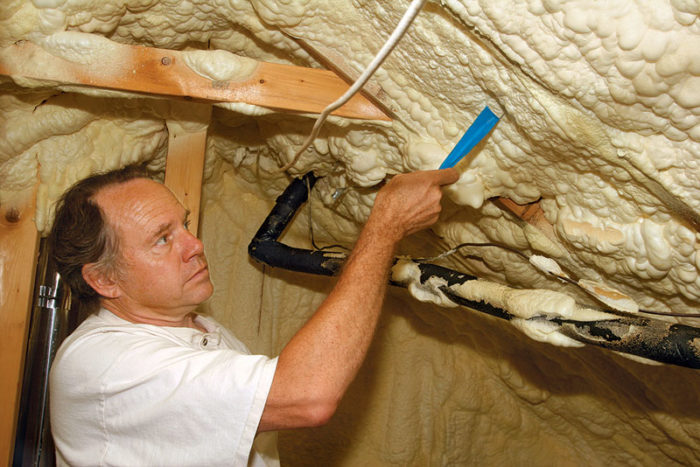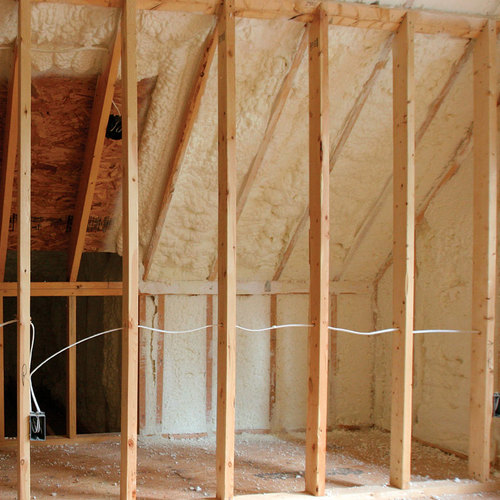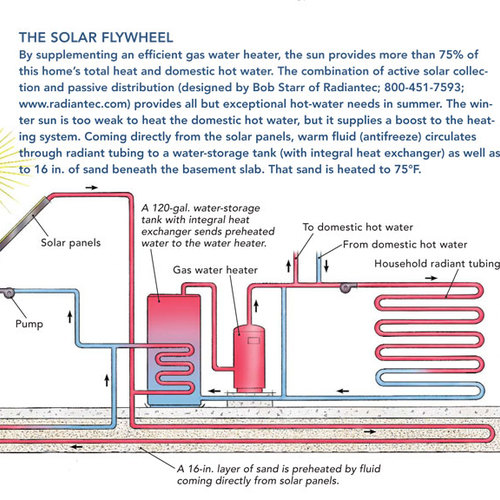
Image Credit: GBA
This week’s Q&A Spotlight begins with a confused architect. Like many other architects and builders, John Brooks had become accustomed to seeing spray-in polyurethane foam that completed encapsulated the rafters when sprayed on the underside of roof decks.
He’d seen Building America projects that included foam at this thickness, and points to numerous projects at GreenBuildingAdvisor where the same thing had been done.
“Almost every Green home tour I have visited in Texas has attic rafters covered in spray foam,” Brooks writes. “My thinking WAS that this practice is acceptable, safe and code approved.”
The emphasis is on “was,” because Brooks had recently come across comments in a GBA blog suggesting that installers are limited by code to foam depths that vary by product but in all cases are no more than 6 in.
“My question seems to be a hot potato,” Brooks writes. “I feel like the student who reminded the teacher that she forgot to assign homework.”
Not a new issue
Brooks’ original query was posted more than a year ago, but the topic continues to generate debate, confusion — and new questions.
The debate isn’t over the thermal performance or air-sealing qualities of the insulation, but how spray-foam is tested for fire safety.
The discussion originally touched on code-required flame-tunnel tests, which evaluate flame spread. GBA advisor Michael Chandler noted that conventional tests were limited to foam thicknesses of 5 in., and that at greater thicknesses alternative test methods were required. Fire resistant barriers, such as drywall or specialized intumescent coatings might be required.
“Just to be clear,” he said, “the alternative test methods are subject to approval on a case by case basis by the inspections department.”
Weekly Newsletter
Get building science and energy efficiency advice, plus special offers, in your inbox.

This article is only available to GBA Prime Members
Sign up for a free trial and get instant access to this article as well as GBA’s complete library of premium articles and construction details.
Start Free TrialAlready a member? Log in













7 Comments
Seems like the short answer
Seems like the short answer is... there is no answer.
And what about thick assembles of sheet foam????
Thickness is meaningless in the NFPA test assembly
There's one minor error in the above statement: "An example is Spraytite by BASF achieving 12 in. thickness with a FS of 25 and SD of 450. Details are here." The ASTM E-84 test for Flame Spread and Smoke Development was done at 4" but the foam was qualified for 12" thick installation in the NFPA 286 test. The NFPA 286 test doesn’t account for flame spread and smoke developed ratings; so technically, the foam listed is Class-I at 4”, just like every other spray foam on the market today.
We've found that after dozens of NFPA room corner tests using both open and closed-cell foams, the initial 40 KW flame source does not burn into the foam more than an inch or two in most cases during an Appendix-X test. It seems that regardless of the thickness, only the surface of the foam is involved in the fire, so we question the need to spray foam in the assembly beyond about 6" thick for the attic and crawlspace test. We believe that spraying more in these test assemblies is wasteful and soon we'll petition the ICC-ES to allow a more reasonable test protocol and not limit the thickness as long as the foam passes the prescribed Appendix-X test.
A second test is required by ICC-ES to qualify your foam to the maximum thickness listed in your ICC-ESR, section 3.2, Surface Burning Characteristics. The test protocol is to spray the foam to the maximum thickness you want the ESR to allow, then cover it with 1/2" gypsum board and run the full NFPA 286 test. Needless to say, this is a test of the gypsum board and not the foam, and we've never seen anything more than some discoloration of the surface of the foam under the gypsum. This test is also wasteful and we’d like to focus our materials, time and money on more meaningful tests like thermal resistance in full-scale assemblies.
Our company is actively engaged in the codes and standards development process and while it’s tedious, we’re working to change some of the antiquated test methods currently required. Spray foam has come a long, long way in the past few decades, and will continue to evolve into an even safer and even more cost effective insulation and air seal.
Mac Sheldon
Western Region Manager
Demilec USA, LLC
GACO
Mac or anyone "in the know" -- what has Gaco-Western done with their foam? Can the experts look into their ESR reports? They are claiming Open Cell can be sprayed in an unvented attic assembly and/or crawlspace with no thermal barrier or ignition barrier (including intumescent coatings). I am hearing the same goes for their Closed Cell. What gives?
The system is working
I'm not sure I understand the point of this article as it could have been written about pretty much every building code. Stop complaining. This is the way it's supposed to be and most (if not all) of the building industry works this way.
This is a political discussion. Legislation and regulation stifle creativity. Take some courses on macro economics if you don't understand that. The problem is the author seems to be trying to do something different. Thinking outside the box is prohibited and he runs the risks of litigation if something goes wrong. He should build a house the way the government mandates.
These codes protect us. When in doubt, we tighten the rules and erode our freedom. Then hail it as a victory when we find some statistic which seems to support the decision.
About 3000 people die each year in residential house fires. That's a tragedy and I don't want to seem like I'm diminishing that. However, there are many causes of house fires and it's unclear (probably unknown) how many people die from burning spray foam. To put it in perspective, consider that 36,000 die from the flue and 450,000 die from heart attacks. It's pretty clear to me that we'd save more lives by making people get flu shots and heeding their cardiologists. You can worry about burning foam killing people, but they are FAR more likely to die from the flu, a heart attach, car accident, or a long list of other maladies.
Do what the building inspector wants and feel good that you're saving personal resources and contributing more to global warming. If something goes wrong, it's the inspector on the hook and he can't be sued. Welcome to America.
spray foam insulation thickness
Study the sciene of spray foam and you find it's not necessary to spray more than 4 inches of closed cell foam in any installation. Since the protocols for testing U and R values don't take into account nearly 0 infiltration losses of foam compared to fiberglass or loose fill insulation. It's the government mandate for minimum R values of insulation that's driving the requirement for thicker foam installations, not actual energy consumption. So the question of how thick can it be for fire protection issues shouldn't even be an issue.
Response to Barton Robinett
Barton,
You wrote, "Study the science of spray foam and you find it's not necessary to spray more than 4 inches of closed cell foam in any installation." This is absolute balderdash.
Four inches of closed-cell foam provides only R-27. The laws of physics cannot be repealed: a ceiling assembly that is insulated to R-27 will lose heat at twice the rate as a ceiling with R-54 insulation. A ceiling insulated to only R-27 will not meet the minimum prescriptive code requirements anywhere in the country -- even in Florida.
For more information on this issue, see It’s OK to Skimp On Insulation, Icynene Says.
We get these questions often
We get these questions often for spray foam installations. Each manufacturer of spray foam can provide cut sheets/technical data sheets for the inspector. Additionally, ESR reports are often needed.
The most common question arising is "do I need an ignition barrier". The answer is, if the mfr. has paid for independent testing and can provide the necessary paperwork, then typically, if the space is "inaccessible" or "accessible only for the service of utilities", then it will not require an intumescent coating. Such a space may not be connected to other areas of the building and cannot have naturally vented combustion appliances in it. If the space does not meat all of these criteria, then yes, it needs an ignition barrier. A 5gal bucket of intumescent paint is under $300 to be applied with an airless sprayer, but sometimes the drywall contractor will send a guy up there for the same price, for one coat tape and spackle.
I have never encountered a question about thickness, because it is only architects and theorists that ever bother to spec more than 8-10" or so of spray foam. I prefer spraying open cell over the rafters when possible, because it avoids shrinkage problems that can occur with such foams. However, I own a spray foam rig, and I wouldn't bother putting more than about 8" of open cell or 5" closed cell. This point is often argued by those who like to crunch numbers in offices, but in practice, the lack of R-value due to reasonable and affordable thicknesses isn't going to be the weak link in the thermal envelope, save for special cases. Some may disagree and consult tables about R-values, calculated losses, etc. I say get out and do more blower door testing, compare heating bills, talk to clientel, and look at the financial aspects/ROI. Fine Homebuilding had a great article regarding the diminishing returns of extra thick SPF installs, which I recommend reading, and I agree that that many times that extra inch of closed cell foam bringing it to say, R-42, makes an insignificant difference. At the end of the day, the utility bill is really the most meaningful indicator of a home's performance, and after spray foaming hundreds of homes, I'll wager on an SPF insulated home with R-21 walls and R-35 rafters performing better than a home with just about any amount of cellulose and/or FG.
Log in or become a member to post a comment.
Sign up Log in